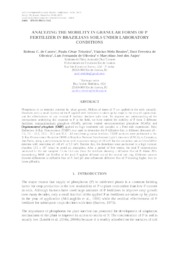Analyzing the mobility in granular forms of P fertilizer in brazilians soils under laboratory conditions.
Analyzing the mobility in granular forms of P fertilizer in brazilians soils under laboratory conditions.
Autoria: CASTRO, R. C. de; BENITES, V. de M.; TEIXEIRA, P. C.; OLIVEIRA, D. F. de; OLIVEIRA, L. F. de; ANJOS, M. J. dos
Resumo: Phosphorus is an essential nutrient for plant growth. Million of tones of P are applied to the soils annually. However, only a small fraction of the P applied with fertilizers is taken up by crops in the year of application, and the effectiveness of any residual P fertilizer declines with time. To improve our understanding of the mechanisms underlying this response to P in the field, we have studied the mobility of P from 3 different fertilizes: monoammonium phosphate (MAP), polymer coated monoammonium phosphate (MAPp) and Organomineral phosphate (OMP) applied on high weathered soil samples in a Petri dish experiment. Total Reflection X-Ray Fluorescence (TXRF) was used to determine the P diffusive flux at different distances (0 - 7.5, 7.5 ? 13.5, 13.5 ? 25.5 and 25.5 ? 43 mm) from granular fertilizer. TXRF analyses were performed at the X-Ray Fluorescence Beamline D09B at Brazilian National Synchrotron Light Laboratory (LNLS), in Campinas, São Paulo, using a polychromatic beam with maximum energy of 20 keV for the excitation and an Ultra-LEGe detector with resolution of 148 eV at 5.9 keV. Besides that, the detections were performed in a high vacuum chamber (2.5 x 10-5 mbar) to avoid air absorption. After a period of five weeks, the total P concentration increased in the soil sampled 7.5 to 13.5 mm from the fertilizer showing a diffusive flux of P. About 20% (considering MAP and MAPp) of the total P applied diffused out of the central soil ring. Different sources showed differences in diffusive flux of P. Soil pH also influenced diffusive flux of P showing higher flux on lower pH soils.
Ano de publicação: 2013
Tipo de publicação: Artigo em anais e proceedings
Unidade: Embrapa Solos
Palavras-chave: phosphorus
Observações
1 - Por padrão são exibidas publicações dos últimos 20 anos. Para encontrar publicações mais antigas, configure o filtro ano de publicação, colocando o ano a partir do qual você deseja encontrar publicações. O filtro está na coluna da esquerda na busca acima.
2 - Para ler algumas publicações da Embrapa (apenas as que estão em formato ePub), é necessário ter, no celular ou computador, um desses softwares gratuitos. Sistemas Android: Google Play Livros; IOS: iBooks; Windows e Linux: software Calibre.
Acesse outras publicações
Acesse a Base de Dados da Pesquisa Agropecuária (BDPA) para consultar o acervo completo das bibliotecas da Embrapa.

